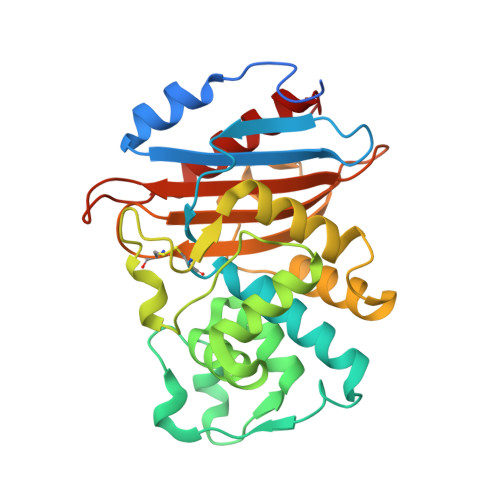Structural Basis and Binding Kinetics of Vaborbactam in Class A beta-Lactamase Inhibition.
Pemberton, O.A., Tsivkovski, R., Totrov, M., Lomovskaya, O., Chen, Y.(2020) Antimicrob Agents Chemother 64
- PubMed: 32778546
- DOI: https://doi.org/10.1128/AAC.00398-20
- Primary Citation of Related Structures:
6V7H, 6V7I - PubMed Abstract:
Class A β-lactamases are a major cause of β-lactam resistance in Gram-negative bacteria. The recently FDA-approved cyclic boronate vaborbactam is a reversible covalent inhibitor of class A β-lactamases, including CTX-M extended-spectrum β-lactamase and KPC carbapenemase, both frequently observed in the clinic. Intriguingly, vaborbactam displayed different binding kinetics and cell-based activity for these two enzymes, despite their similarity. A 1.0-Å crystal structure of CTX-M-14 demonstrated that two catalytic residues, K73 and E166, are positively charged and neutral, respectively. Meanwhile, a 1.25-Å crystal structure of KPC-2 revealed a more compact binding mode of vaborbactam versus CTX-M-14, as well as alternative conformations of W105. Together with kinetic analysis of W105 mutants, the structures demonstrate the influence of this residue and the unusual conformation of the β3 strand on the inactivation rate, as well as the stability of the reversible covalent bond with S70. Furthermore, studies of KPC-2 S130G mutant shed light on the different impacts of S130 in the binding of vaborbactam versus avibactam, another recently approved β-lactamase inhibitor. Taken together, these new data provide valuable insights into the inhibition mechanism of vaborbactam and future development of cyclic boronate inhibitors.
- Department of Molecular Medicine, University of South Florida Morsani College of Medicine, Tampa, Florida, USA.
Organizational Affiliation:


















